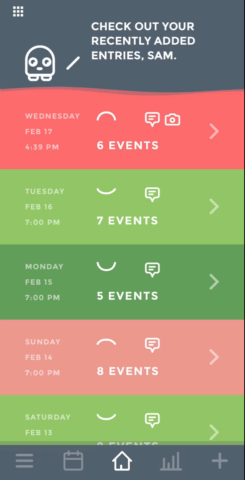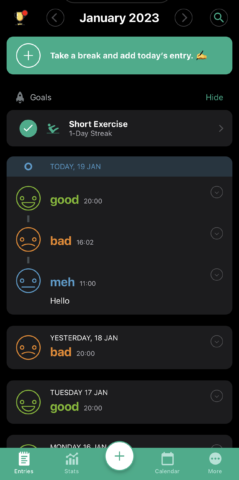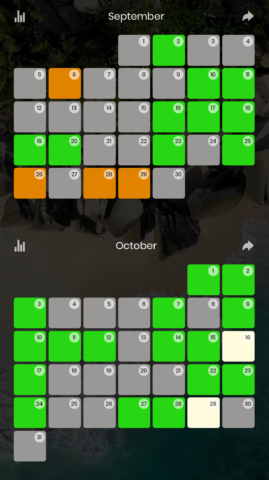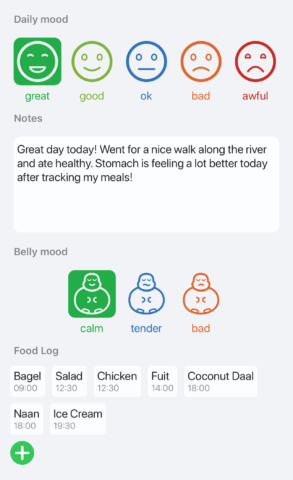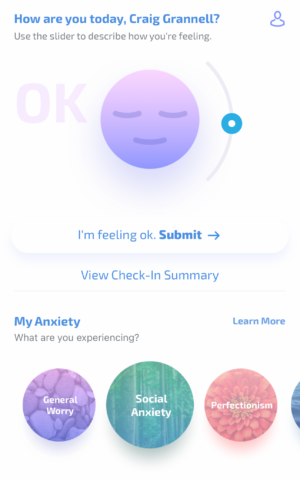Track how you feel and use data and tools to make meaningful life changes
Apple’s health app is concerned with raw, measurable data points. It’s less useful with subjective aspects of health, like how you feel. You can log ‘mood changes’ in the Symptoms section of Health Categories, but doing so doesn’t provide granular data and context.
The apps in this round-up take a different approach. They allow you to track how you feel, and you augment those ratings with other details. This gives you the opportunity to spot patterns. If you find you’re content (or not) during specific moments in your life, you can then potentially make adjustments accordingly.
Moodistory ($6.99/£5.99)
Our favorite mood tracker, Moodistory has a friendly, modern interface. You can quickly and easily enter mood readings across a five-step range, and optionally add what triggered the input. Your location, a photo and written thoughts can expand an entry.
Over time, what you log fashions color-coded timeline and calendar views, making it a cinch to see if your mood lifts or dips on certain days. Tap any day and you can view its extended information. A stats view provides another angle on your data, with averages over a defined date range, mood progression and mood distribution.
The app affords you a certain amount of customization. Most importantly, you can set reminders to alert you to log your mood. But you can also fine-tune interface colors, backup data to iCloud, and export a properly impressive PDF of your moods feed for perusal and archiving. It’s an elegant, simple app, and the one-off payment is great value for such a premium product.
Daylio Journal (free + IAP)
The most famous app in this round-up, Daylio again encourages you to log your mood and activities. The latter are initially geared towards leisure and people, but can be customized.
Entries are displayed as a scrolling, focused journal of sorts, into which you can integrate goals designed to improve your mood. These include getting more sleep and reducing stress. You outline a ‘times per week’ target and go from there.
The interface is clean and usable. The Stats tab shows how your mood has changed over time, along with recent achievements. But it outlines the free tier’s limitations, gating several graphs. Similarly, you can only run a single goal – unless you pay.
The $19.99/£18.99 annual price isn’t too onerous and also adds backups, advanced stats, custom templates and data export. But perhaps try it for a month to see if you get enough value, because a combination of Moodistory and Streaks might better suit – and you only pay for those once.
Moodflow (free + IAP)
This alternative free mood tracker echoes Moodistory, but its nuances make for a different feel. There’s more going on, which makes it less restful and user-friendly; but it can capture far more information.
Along with logging your mood, you can define emotion tags for entries, and note down sleep hours, physical activity, medication, social interaction, symptoms, and more. Multiple views help you surface information, such as the Journal tab, which flanks color-coded dates with written notes.
Elsewhere, the app bundles habit challenges, which are fine, but not on a par with Streaks. However, the customization options impress, letting you adjust elements of the interface.
The app has one big flaw, though: it’s not been updated in a year and places headings behind Dynamic Island on modern iPhones. The lack of updates makes us wary about the paid version, which is a pity, since it offers insight correlations and timeframe comparisons. Still, the free version is solid if you ignore the niggles.
Belly Boi (free or $2.99/£2.49)
We’ve covered three generalist mood trackers, but Belly Boi is specialist fare. It helps people who find their mood is impacted by what they eat, by logging a daily mood and a belly mood, along with food intake.
In the calendar view, each entry’s central color outlines the daily mood, and the border shows the belly mood. This works well, although there’s no granularity for people who find one meal scuppers a day. They must decide whether to log the day’s worst moment or more of an ‘average.’ A notes field at least helps you add further details.
Elsewhere, you get iCloud sync, a smattering of customization options, and JSON data export. It’s simpler than the other apps on test, but ideal for the target audience. Also, the small donation is optional – the app has no ads or feature locks. So if you find Belly Boi useful, do pay to show your appreciation.
MindShift CBT (free)
Like Belly Boi, this app is more focused than generalist, but is designed for anxiety relief. You log how you’re feeling and can view a summary of recent days – although there’s no calendar view, which is a pity.
What the app does have is a lot of information and tools. You can dig into recommendations for a range of anxiety issues, and find ideas to calm you. There‘s a goals system to help identify where you want to go – and steps to get there. For more immediate concerns, a central button provides fast access to a breathing aid, coping cards, and ideas for taking a small step away from anxiety.
The emphasis here is more on solutions than mood tracking. But Mindshift’s quality and lack of a price tag makes it worthy of consideration for anxiety sufferers looking for assistance with a side order of mood tracking.

